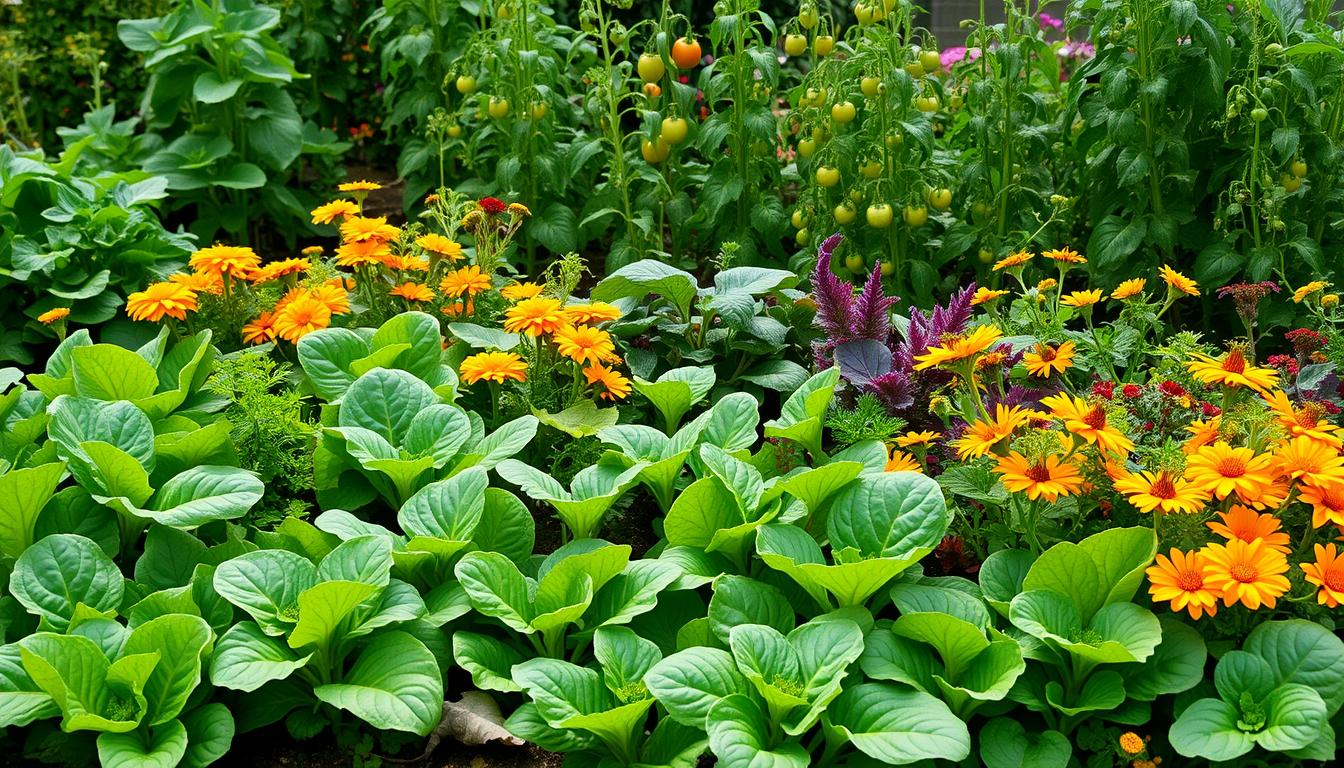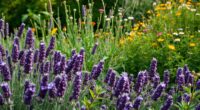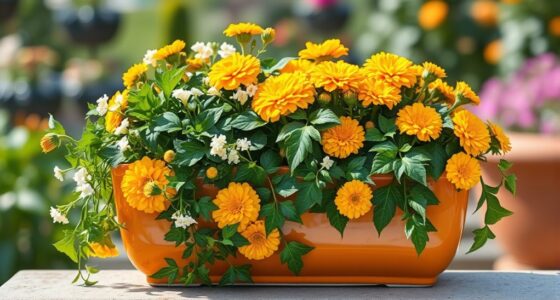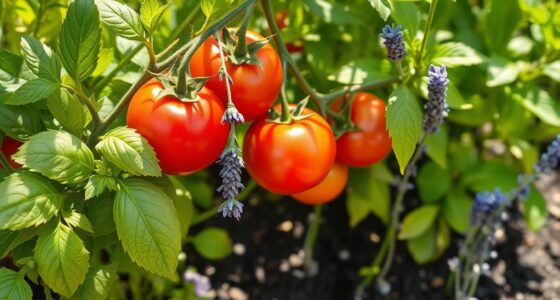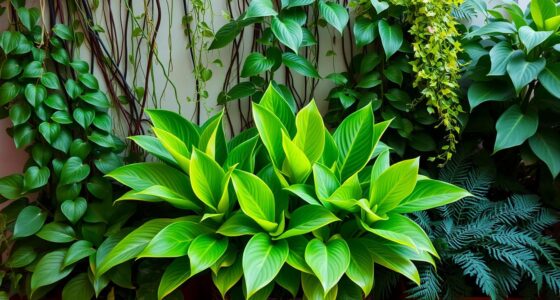Imagine stepping into your garden, the sun warming your skin and the air filled with the rich, earthy scents of flourishing plants. As you approach your patch of Swiss chard, its vibrant greens beckon your admiration. But have you ever considered that the magic of your garden goes beyond just the chard? The world of companion planting offers a rich tapestry of relationships that not only nurtures your Swiss chard but also enhances the overall beauty and productivity of your garden. By discovering the best companion plants for Swiss chard, you’re not only cultivating a healthier crop but also fostering a lively ecosystem that thrives on mutual benefits. Together, these plants can improve soil health, deter pests, and create a sanctuary for beneficial insects, making your garden an inviting refuge for both you and nature.
This exploration into the best Swiss chard planting companions is about more than just growing food—it’s about creating a vibrant garden that tells a story of care and connection. Welcome to the world of Swiss chard companion plants, where each planting decision contributes to a lush, harmonious garden space.
Key Takeaways
- Companion planting improves garden productivity and health.
- Swiss chard benefits from partnerships with specific plants.
- Good companions can help deter pests and attract beneficial insects.
- Healthy soil conditions enhance the growth of Swiss chard.
- Creating a vibrant garden enhances your overall gardening experience.
Why Companion Planting Matters for Swiss Chard
Companion planting holds significant importance for your Swiss chard garden. This practice optimizes nutrient availability and manages pest populations effectively. Different plants can complement each other, enhancing your overall gardening experience while contributing to a vibrant ecosystem.
Benefits of Companion Planting
The benefits of companion planting are vast and can transform your gardening outcomes. Here are some key advantages:
- Enhanced Soil Health: Various plants can improve soil composition, allowing Swiss chard to thrive.
- Pest Control: Certain companions deter pests, protecting Swiss chard from infestations.
- Efficient Space Utilization: Grow plants that occupy different vertical and horizontal spaces, maximizing your garden layout.
- Stress Reduction: Companion plants can reduce competition for nutrients, promoting healthier growth.
Common Companion Planting Myths
Understanding companion planting myths is crucial for effective gardening. Here are a few to consider:
- Not all plants thrive together. Some may compete for resources, leading to disappointing results.
- All plants can grow together seamlessly. This belief can lead to poor planting choices.
- Companion planting is a one-size-fits-all approach. Each garden has unique conditions that affect plant relationships.
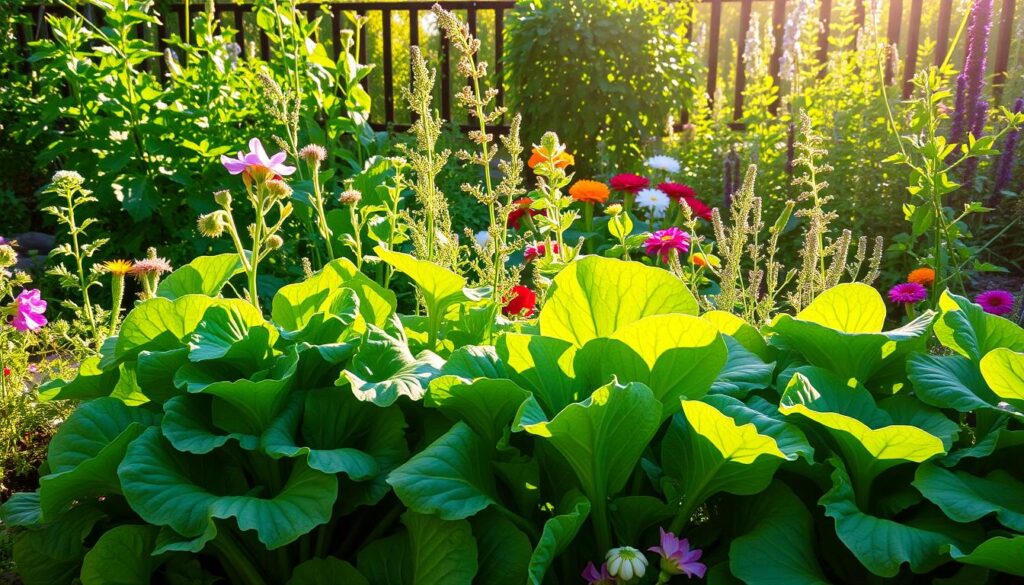
Ideal Soil Conditions for Growing Swiss Chard
Creating the perfect environment for your swiss chard garden companions starts with understanding soil conditions. Swiss chard flourishes in well-draining, nutrient-rich soil that maintains optimal moisture levels. The right soil contributes significantly to the health and productivity of your plants.
Importance of Soil pH
Maintaining a balanced soil pH is crucial for growing swiss chard. The ideal soil for swiss chard should have a pH between 6.0 and 7.0. This range ensures that essential nutrients are available for uptake by the plants. If your soil is too acidic or alkaline, growth may be stunted and nutrient deficiencies could occur.
Nutrient-Rich Soil Mix
Incorporating organic matter into your soil is an excellent way to enrich its quality. A mix of compost, well-balanced fertilizers, and natural amendments will provide the necessary nutrients for robust growth. This nutrient-rich soil mix not only benefits the swiss chard but enhances the garden’s ecosystem, supporting its companions in the growing process.
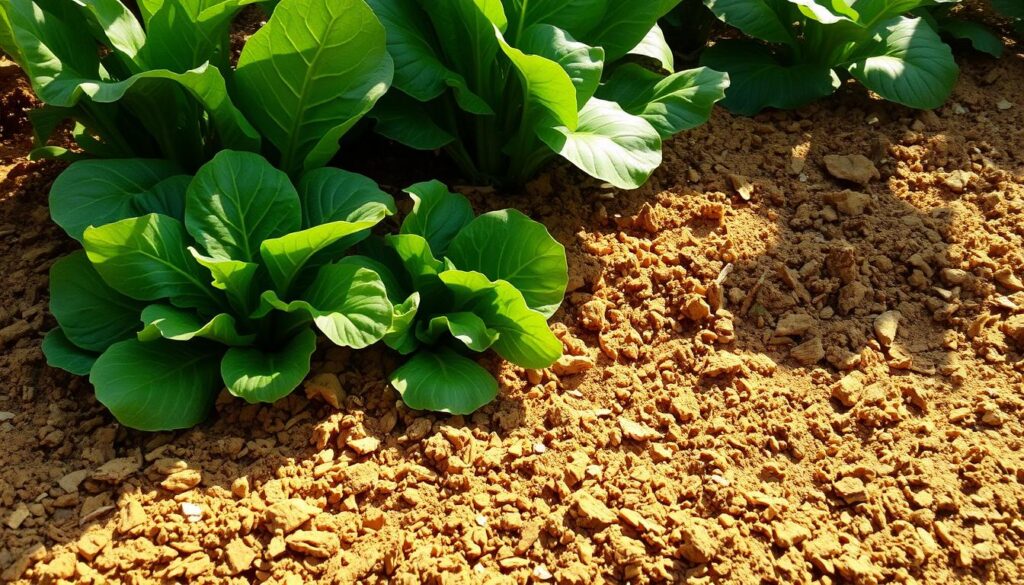
| Soil Component | Benefits |
|---|---|
| Compost | Adds nutrients and improves soil structure. |
| Well-Balanced Fertilizers | Provides essential macro and micronutrients for growth. |
| Organic Matter | Enhances moisture retention and microbial activity. |
| Mulch | Helps maintain soil moisture and reduces weed competition. |
With the right soil conditions, you can enjoy thriving swiss chard and its garden companions well into the growing season.
Top Companion Plants for Swiss Chard
Growing Swiss chard alongside the right plants can significantly boost your garden’s productivity. Understanding the best companion plants for Swiss chard is essential for creating a thriving garden environment. Here are some excellent options that work harmoniously with Swiss chard planting companions.
Beets: A Perfect Match
Beets thrive in similar soil conditions as Swiss chard, making them an ideal companion. Both plants prefer well-draining, nutrient-rich soil. Maintaining some distance between them is advisable, as it reduces the risk of pests targeting both crops simultaneously. This setup allows for effective growth while optimizing the available space in your garden.
Celery: Complementary Growth
Celery serves as a fantastic companion due to its compact growth habit. This plant doesn’t compete for resources with Swiss chard, allowing both to flourish simultaneously. The high moisture requirement of celery complements the needs of Swiss chard, creating a synergistic growing environment where both can thrive together.
Rosemary: Enhances Flavor
Integrating rosemary into your garden not only enhances the flavor of Swiss chard but also helps deter pests. This aromatic herb thrives in similar soil types, adding depth to your garden’s ecosystem. Additionally, rosemary’s robust nature ensures it can withstand competition, benefiting both itself and your Swiss chard plants.
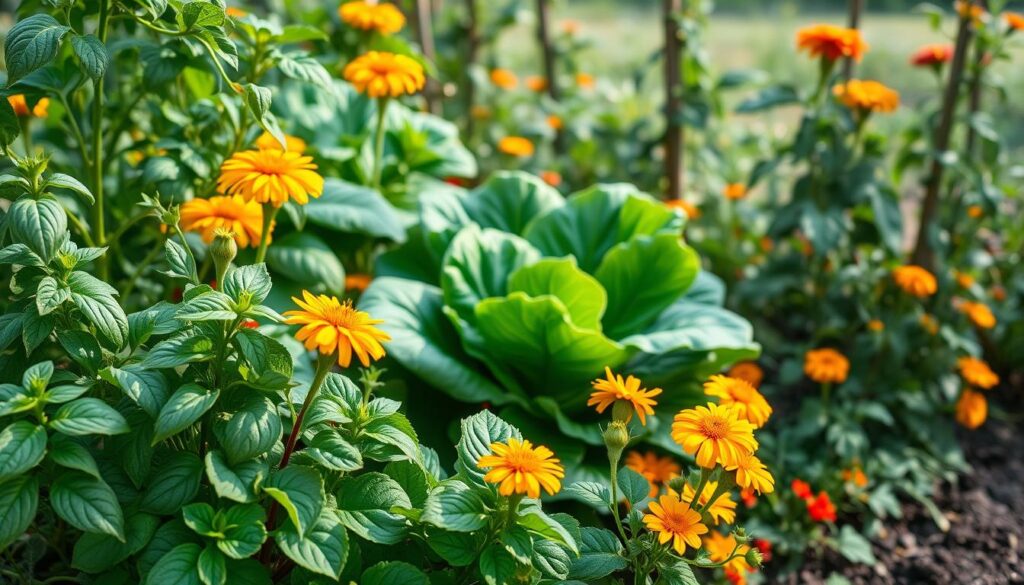
| Plant | Benefits | Growing Conditions |
|---|---|---|
| Beets | Enhances nutrient sharing | Well-drained, nutrient-rich soil |
| Celery | Compliments growth, conserves moisture | Moist, nutrient-dense soil |
| Rosemary | Flavor enhancement, pest deterrent | Well-drained, sunny location |
Choosing these best companion plants for Swiss chard will undoubtedly contribute to a healthier garden and a more bountiful harvest.
Herbs That Harmonize with Swiss Chard
Incorporating certain herbs with swiss chard can significantly enhance your garden’s productivity and flavor. By choosing organic companion plants for swiss chard, you create a thriving ecosystem that benefits both your vegetables and herbs. Two standout herbs that blend well with swiss chard are basil and dill.
Basil: A Culinary Delight
Basil not only adds a wonderful flavor to dishes featuring swiss chard but also acts as a natural pest deterrent. Its strong aroma repels harmful insects, helping to keep your garden healthy and vibrant. By planting basil alongside swiss chard, you can enjoy a delightful culinary experience while boosting your garden’s health.
Dill: Attracts Beneficial Insects
Dill serves an important role in attracting beneficial insects that assist in managing pest populations. Wasps and hoverflies, drawn to dill, help control unwanted pests that might target your swiss chard. This relationship makes dill an excellent choice when planting organic companion plants for swiss chard, as it promotes ecological balance in your garden.
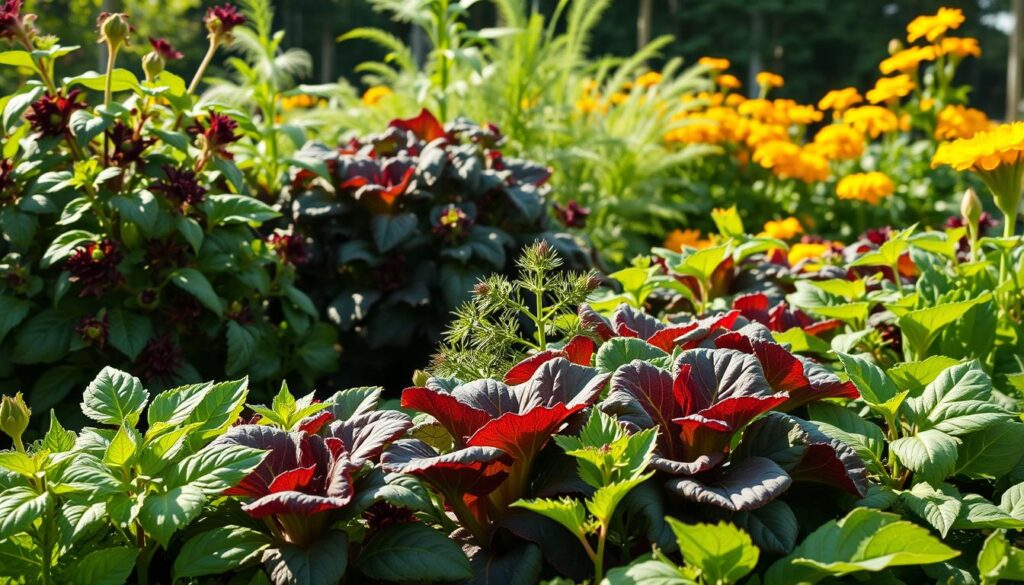
| Herb | Benefits |
|---|---|
| Basil | Enhances flavor and deters pests. |
| Dill | Attracts beneficial insects and supports pest control. |
Vegetables that Thrive Alongside Swiss Chard
When planning your garden, include vegetables that support the growth of Swiss chard. Each vegetable offers unique benefits, allowing you to create a vibrant and productive garden. The following options are ideal companions and deserve a spot in your swiss chard companion planting guide.
Radishes: Quick Growers
Radishes are excellent companions for Swiss chard, thanks to their rapid growth cycle. You can sow radishes alongside chard as a temporary crop, enjoying a quick harvest while your chard matures. Their presence helps deter pests, including aphids, contributing to a healthier growing environment.
Carrots: Deep-Rooted Friends
Carrots thrive next to Swiss chard, as their deep roots allow them to access nutrients at different soil levels. This non-competitive nature enables both plants to flourish. Incorporating carrots into your planting scheme ensures a diverse vegetable harvest alongside your chard.
Onions: Natural Pest Deterrents
Onions provide natural pest-repelling properties, making them valuable companions for Swiss chard. Their strong scent can deter pests that might otherwise harm your chard. By planting onions near chard, you contribute to a more resilient garden ecosystem.
| Vegetable | Growth Characteristics | Benefits to Swiss Chard |
|---|---|---|
| Radishes | Quick-growing, short lifecycle | Deters pests, early harvest |
| Carrots | Deep-rooted, slower growth | Non-competitive, nutrient access |
| Onions | Moderate growth, strong scent | Pest deterrent, enhances health |
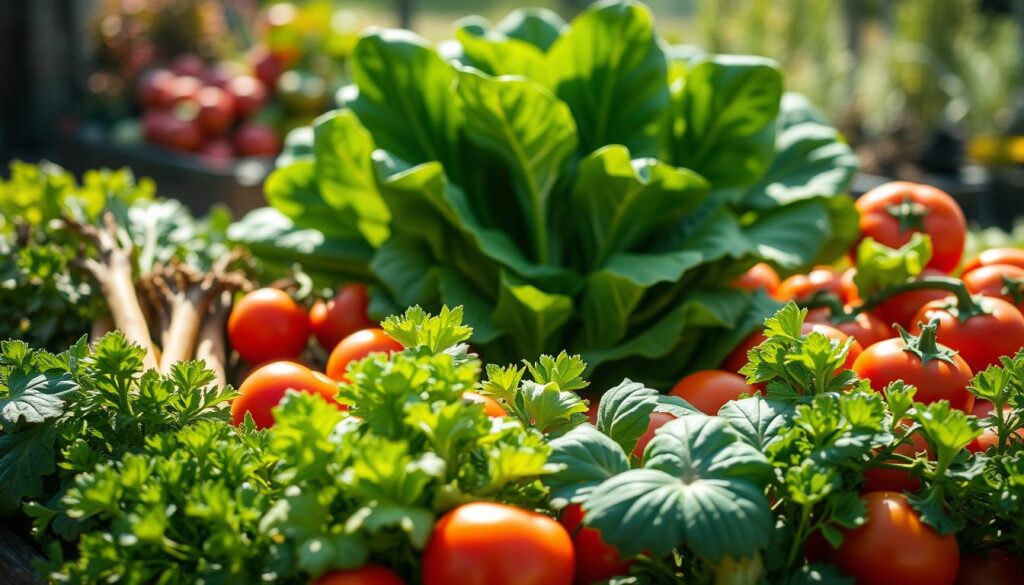
Flowers to Consider as Companion Plants
When planning your garden, incorporating flowers alongside Swiss chard can boost not only aesthetics but also productivity. Certain flowers act as effective companions for Swiss chard, enhancing its growth, improving pest management, and attracting beneficial insects.
Marigolds: Pest Management
Marigolds are a popular choice as companion flowers for Swiss chard due to their natural pest-repelling properties. These vibrant flowers can deter pests like nematodes and aphids, allowing your Swiss chard to flourish without the threat of infestations. The added bonus is their beautiful yellow and orange blooms, which brighten up your garden.
Nasturtiums: Edible Beauty
Nasturtiums serve as a dual-purpose flower, functioning both as an edible plant and a trap crop. Their bright flowers attract pollinators while simultaneously luring aphids away from your Swiss chard. This natural pest deterrent strategy helps maintain a healthy balance in the garden, making nasturtiums an ideal choice for companion flowers alongside Swiss chard.
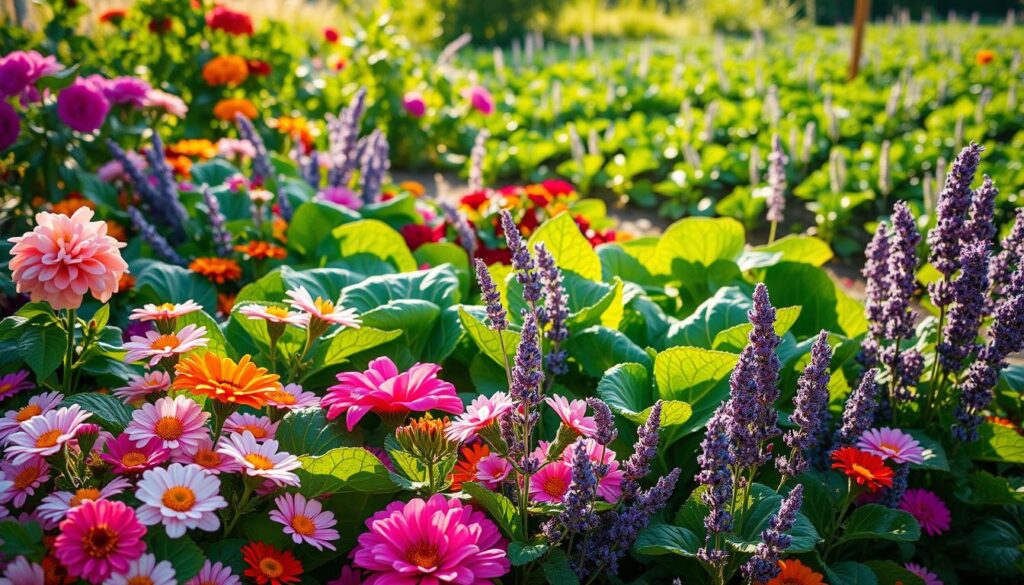
| Flower Type | Pest Management | Edible |
|---|---|---|
| Marigolds | Deters pests like nematodes and aphids | No |
| Nasturtiums | Attracts pollinators and traps aphids | Yes |
Selecting the right flowers alongside Swiss chard can significantly enhance your garden’s ecosystem. Their role as companion flowers not only aids in pest management but also contributes to a vibrant and flourishing garden environment.
Avoiding Poor Companion Plants for Swiss Chard
Choosing the right companion plants for Swiss chard can significantly influence its growth and overall health. To ensure a thriving garden, you must be aware of the bad companion plants for Swiss chard. Recognizing these less-than-ideal neighbors will help you maintain a productive planting environment.
Plants to Keep at Bay
Certain plants can compete for nutrients and attract similar pests, making them unsuitable companions for Swiss chard. For example:
- Spinach: Shares nutrient needs and pest attractivity with Swiss chard.
- Beets: Both belong to the same family and can exacerbate pest issues.
- Swiss chard: Planting it alongside itself can lead to increased competition for resources.
Understanding Plant Conflicts
Understanding plant competitors is essential for fostering a healthy garden. By avoiding specific pairings, you minimize conflicts that can hinder growth. The competition between Swiss chard and its unsatisfactory companions may lead to:
- Decreased nutrient availability.
- Increased susceptibility to pests.
- Reduced overall yield.
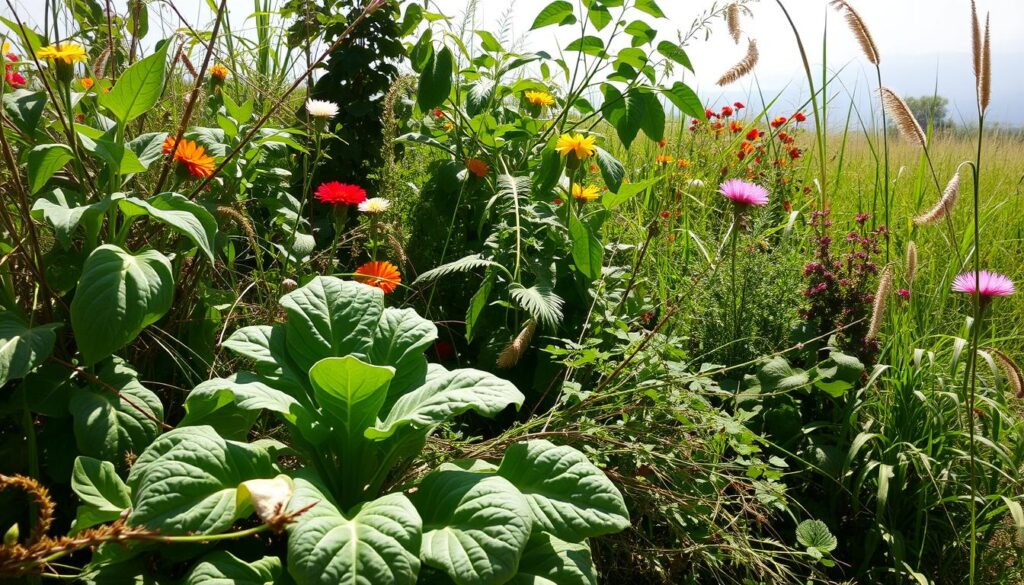
Focusing on suitable companions while steering clear of bad options can enhance your Swiss chard’s potential and health. By understanding plant competitors, you create a flourishing garden where your Swiss chard thrives.
Seasonal Planting Tips for Swiss Chard
Understanding the right timing for planting can significantly enhance your experience with Swiss chard. Following seasonal planting tips for swiss chard will not only help you maximize your yield but also ensure that your garden remains vibrant and productive.
Best Times to Plant Companion Plants
The best times to plant Swiss chard and its companion plants are during the cool days of spring or fall. This timing creates a favorable environment for growth. Consider planting your companions like beets and onions alongside Swiss chard to optimize their growth potential. Staggering your planting times can also lead to a more varied harvest and make the most of your garden space. Enjoying fresh crops throughout the growing season will keep your meals tasty and your garden flourishing.
Crop Rotation for Healthier Growth
Implementing crop rotation for swiss chard is essential for maintaining soil health and preventing pest infestations. Rotate your crops annually to reduce the stress on your soil, which can lead to depletion of nutrients. By mixing in different plants each season, you can enhance the vitality of your garden. This practice encourages biodiversity and contributes to a more resilient ecosystem that supports healthier growth for your Swiss chard and its companions.

Pest Management with Companion Planting
Incorporating companion planting strategies into your garden can be essential for effective pest management with Swiss chard. This natural technique involves using certain plants to deter pests and promote a healthier environment for your veggies. By selecting the right companions, you can enhance your garden’s resilience against unwanted insects.
How Companion Plants Help Control Pests
Companion pest control plays a crucial role in maintaining a robust garden. For instance, plants like marigolds and nasturtiums are known to repel harmful pests while attracting beneficial insects that prey on garden nuisances. When you combine species such as Swiss chard with these flowering plants, you create a protective barrier that reduces pest infestations significantly.
Attracting Beneficial Insects
Encouraging beneficial insects, like ladybugs and lacewings, is another advantage of companion planting. These insects serve as natural predators to aphids and other harmful pests. By planting specific herbs and flowers amongst your Swiss chard, you can create a welcoming habitat for these insects. This relationship fosters a balanced ecosystem that benefits all plants in the vicinity.
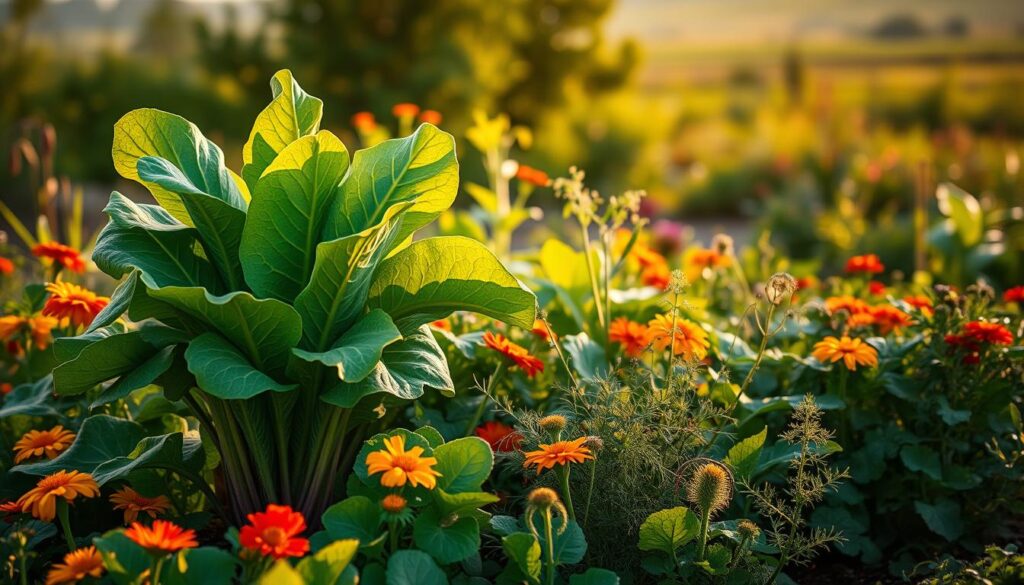
| Companion Plant | Benefit | Pests Controlled |
|---|---|---|
| Marigolds | Repel nematodes and attract beneficial insects | Aphids, Whiteflies |
| Nasturtiums | Trap crop for aphids | Aphids |
| Dill | Attracts predatory pests like ladybugs | Aphids, Spider Mites |
| Borage | Improves growth and attracts pollinators | Harmful beetles |
Watering and Nutrition Considerations
Understanding the watering needs for swiss chard is essential for maintaining healthy plants. This leafy green thrives best with consistent moisture, particularly in the warm summer months. Proper hydration not only supports Swiss chard but also enhances the growth of its companions in the garden.
Companion Plant Water Requirements
When selecting companion plants, consider their individual water needs. Some may require more moisture, while others prefer drier soil conditions. Effective interplanting can create a harmonious balance, ensuring all plants receive the moisture needed without overwhelming any specific species. Positioning plants together that share similar watering needs promotes growth and reduces stress on the plants.
Nutrient Sharing Between Plants
Companion planting fosters a unique interaction where nutrition for swiss chard companions can be mutually beneficial. Plants rooting at different depths can access various nutrients from the soil, which minimizes competition. This diverse plant community helps create a healthier ecosystem, allowing all species to flourish. Utilizing this approach can lead to more productive and robust gardens.
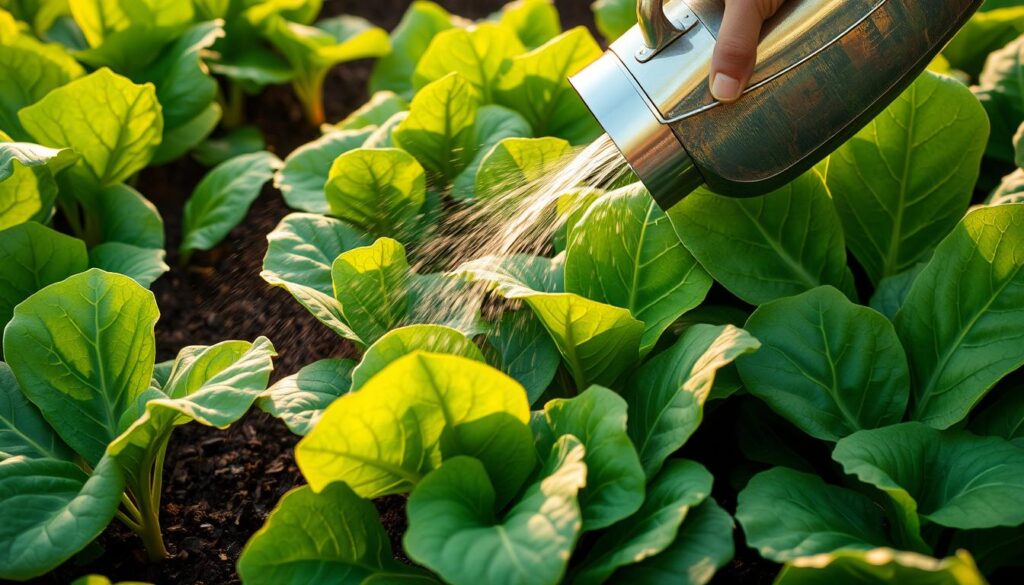
| Plant | Water Needs | Nutrient Benefits |
|---|---|---|
| Swiss Chard | Moderate | High in magnesium and potassium |
| Beets | Moderate | Boosts soil potassium |
| Onions | Low | Enhances nitrogen uptake |
| Radishes | Low to Moderate | Improves nutrient availability |
| Celery | High | Helps retain soil moisture |
Swiss Chard and Pollinators: A Guide
Incorporating pollinator-friendly plants around your Swiss chard enhances its growth while creating a vibrant garden ecosystem. Attracting pollinators to swiss chard leads to improved yields and a more balanced environment. Pollinators like bees and butterflies play a critical role in the reproduction of many plants, including Swiss chard.
Attracting Bees and Butterflies
To draw in these essential creatures, consider planting flowers such as dill, which is known for luring various pollinators. Nasturtiums also serve as excellent companions, providing a feast of colorful blooms that appeal to both bees and butterflies. These plants not only support pollinator activity but also enhance the visual appeal of your garden, making it a delightful space to enjoy.
Companion Plants for Pollinator Support
When selecting companion plants for pollinator support, keep in mind the benefits of increasing biodiversity in your garden. Here’s a list of effective options:
- Dill
- Nasturtiums
- Lavender
- Sunflowers
- Bee Balm
By strategically placing these pollinator-friendly plants near your Swiss chard, you can boost attraction and create an inviting environment for bees and butterflies. A rich diversity of plants not only supports the pollinators but also enhances the overall health and productivity of your garden.
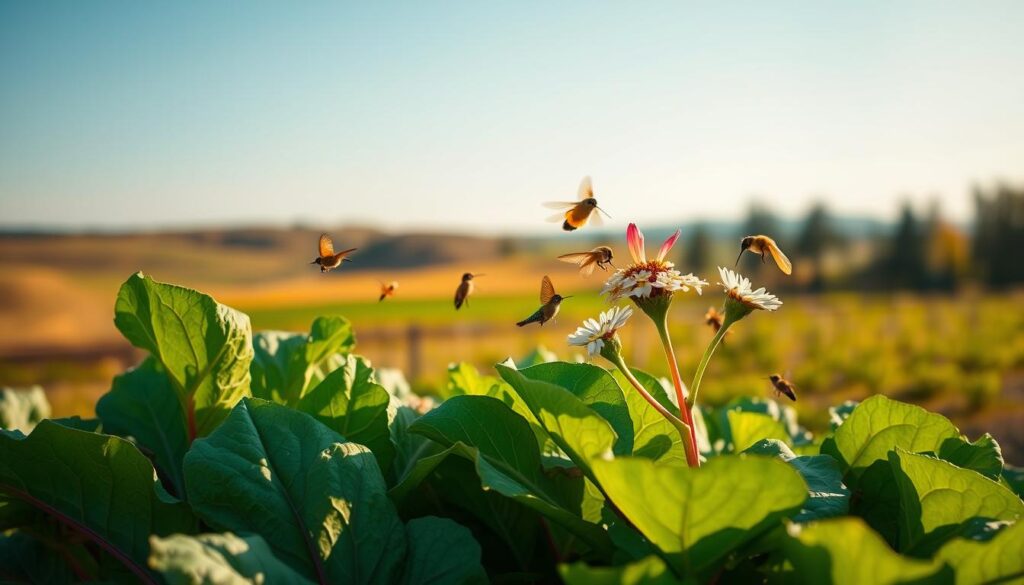
Growing Swiss Chard in Containers
Container gardening with swiss chard opens up numerous possibilities for urban gardeners and those with limited space. This versatile plant thrives in pots, making it a favorite for balcony and patio gardens. To enhance your container gardening experience, selecting the best companions for container plants can significantly impact growth and yield.
Best Companions for Container Gardening
When pairing plants in a container, consider herbs and flowers that work well alongside swiss chard. Suitable companions include:
- Basil – This aromatic herb not only complements the flavor of swiss chard but also repels harmful pests.
- Marigolds – These vibrant flowers deter pests and attract beneficial insects, benefiting your entire container garden.
- Dill – Known for attracting pollinators, dill can help promote a thriving ecosystem within your pots.
Soil and Water Considerations
For successful container gardening with swiss chard, use nutrient-rich soil combined with a quality potting mix to ensure proper drainage. Regular watering is essential, especially during hot weather. Monitor moisture levels carefully to prevent both overwatering and drought stress.
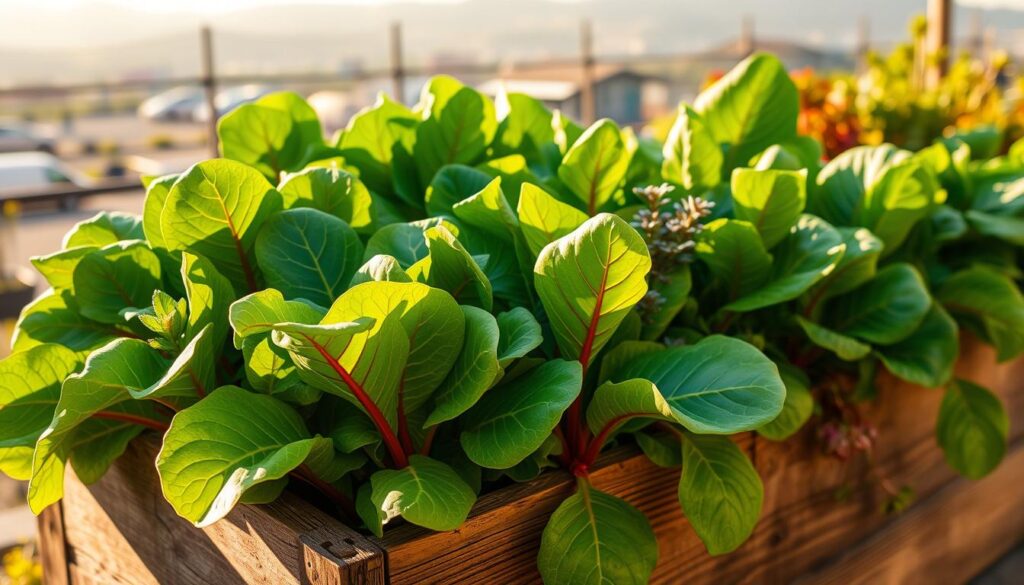
Harvesting Swiss Chard: Methods and Timing
Understanding when to begin harvesting swiss chard is essential for ensuring a flavorful and abundant yield. You can start harvesting once the leaves are substantial enough, typically around 6 to 8 inches long. Regular cutting encourages new growth, promoting a continual harvest throughout the season.
Knowing When to Harvest
Observing the leaves closely will help you grasp the timing for swiss chard harvest. Pick outer leaves first, allowing the inner ones to thrive and grow. Harvesting in the morning can yield fresher tastes, as their water content is higher at this time.
Impact of Companion Plants on Yield
Companion plants play a crucial role in enhancing the overall yield of swiss chard. Nutrient-dense partners can enrich the soil, while others may help deter pests, leading to healthier plants. Consider planting crops like beets and onions alongside your swiss chard. They not only complement each other in growth patterns but can contribute to a more vigorous and fruitful harvesting experience.
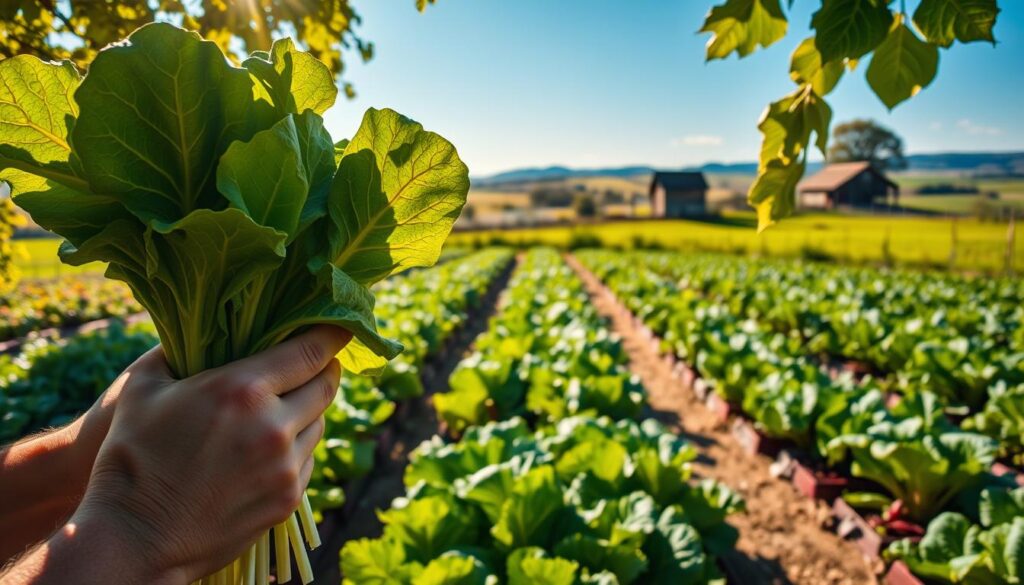
Creative Cooking with Swiss Chard
Swiss chard opens up a world of culinary possibilities, working beautifully with various ingredients from your garden. By integrating fresh herbs or vegetables into your swiss chard recipes, you can enhance flavors and create delightful dishes that are sure to impress.
Recipes Highlighting Companion Plant Combinations
Combining swiss chard with companion plants like basil and dill not only boosts taste but also provides an aromatic experience. Consider trying a sautéed swiss chard dish with garlic and cherry tomatoes, or a savory swiss chard and basil pesto pasta. These recipes exemplify how powerful companion plant pairings can elevate your meals.
Preserving Your Harvest: Tips and Tricks
Preserving swiss chard is a smart way to enjoy its flavors long after the harvest. Freezing works exceptionally well; blanch the leaves briefly, then cool and store in airtight bags. Another method is drying, which concentrates flavor while ensuring you have this nutritious green year-round. Whether you choose to freeze or dry, your preserved supply will come in handy for a variety of recipes.

Conclusion: Enjoying a Healthy Garden Ecosystem
As you wrap up your journey with Swiss chard and its beneficial companions, consider the incredible impact of companion planting on your garden. By strategically pairing Swiss chard with compatible plants, you can work towards maximizing your gardening space while enhancing the overall health of your garden. This method not only allows for robust yield but also contributes to a thriving environment where each plant supports the others, creating a healthy garden ecosystem.
Maximizing Your Gardening Space
Utilizing maximizing garden space with swiss chard effectively means prioritizing diverse plant arrangements. Each companion plant, whether it be beets, basil, or marigolds, plays a unique role, contributing nutrients and fostering healthier growth patterns. Through thoughtful placement and careful selection, you ensure that your garden not just flourishes, but becomes a model of efficiency and sustainability.
Encouraging Biodiversity in Your Garden
Encouraging biodiversity is essential for long-term gardening success. A varied garden attracts beneficial insects and creates a balanced ecosystem that thrives without excessive intervention. By integrating Swiss chard with its companions, you cultivate an environment where natural pest control and nutrient sharing occur harmoniously. This not only benefits your plants but also enriches the gardening experience, allowing you to enjoy a vibrant and sustainable planting space.
